Betta fish – They’re more complex than people think. They’re usually purchased from a pet store with little to no instructions, along with a hearty “Good luck!”
One assumption is that if they’re laying at the bottom of the tank, they’re just chillin’ out when, in fact, there are lots of reasons they could be there.
So on the agenda today is to teach you about these stunning creatures and why they might be hanging out in their downstairs apartment.
We’ll cover the various reasons why your betta fish (pronounced “bet-ta,” not “bay-ta”) isn’t moving and how the following issues could be the culprit:
- Improper eating habits
- Lack of environmental features
- Swim bladder disease
- Fin rot
- The wrong tankmates
Now let’s jump right into the water to investigate this fin-tastic fish and see how you can help them make it through some tough situations. (And an easy one if they’re just taking a snooze.)
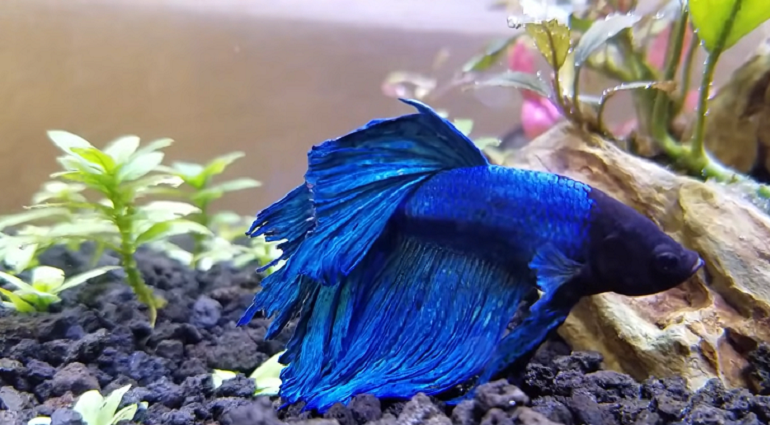
About the Swimming Show-off – the Betta Fish
It’s almost like they know they’re gorgeous. They swim through the water with their fins flowing about like a supermodel. And they’re certainly a favorite of humans. Betta fish constantly see us pointing at them through the glass because of their beauty.
Their other name is “Siamese fighting fish,” and they’re one of the oldest species of domesticated fish. Discovered in Southeast Asia, betta fish were named by an ancient clan of warriors.
Wild bettas live in shallow freshwater, and their scientific name is Betta splendens meaning “shining enduring fish.” From rice paddies in Thailand to aquariums all over the world, the betta fish is downright famous.

If you have one, you know they’re easy to love. What you may not know are all the reasons why you might find your betta fish laying on bottom of tank. So let’s chat.
Reasons Why Betta Fish Laying on Bottom of Tank
There are multiple reasons why your Betta fish is not moving or laying still at the bottom of the betta tank.
Sleeping Betta Fish
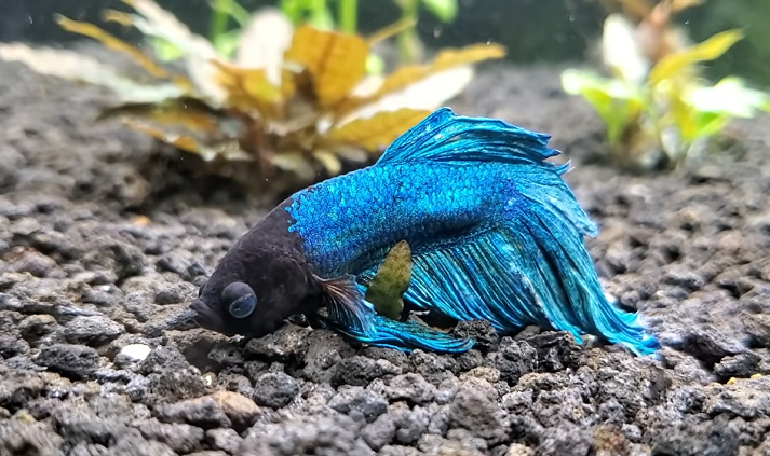
Fish gotta sleep. But you won’t find them in the same area of the tank when they’re sawing logs. They’ll sleep in tank ornaments, near plants, on the bottom, near the top, and they even enjoy hammocks! Leaf hammocks, that is.
Betta fish tend to sleep at night and take several naps a day. If you find yours being quite still at the bottom of the Betta tank at night, don’t tap the glass. (Unless, of course, you’re worried about his safety if he was drinking and diving the night before.)
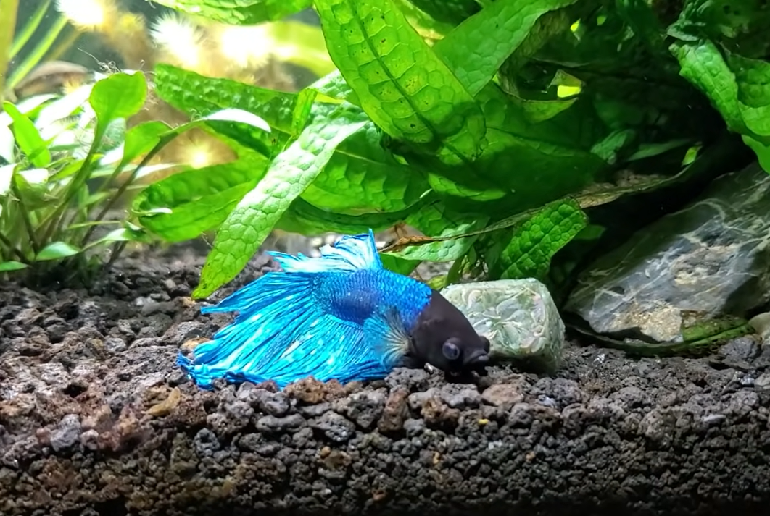
Try not to panic if you see your bettas sleeping vertically. They can sleep in some strange positions.
Since Betta fish don’t have eyelids, it can be hard to tell if they’re sleeping. Watch them at night to see if they’re near decorations/ornaments, beside the filter, or at the bottom. Just turn the lights off at night to make sure they’re acclimated to nighttime and daylight hours.
Older Bettas like Resting at the Bottom
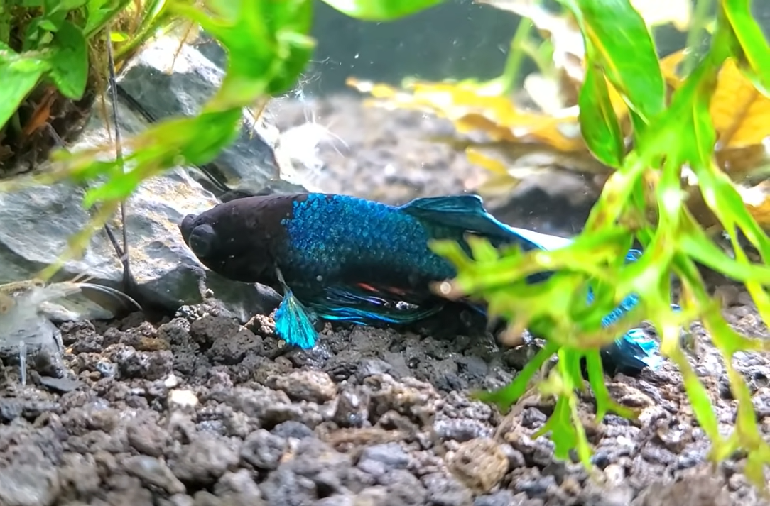
The lifespan of a captive Betta fish is 2-4 years. Of course, some have lived longer, but this is the average.
Although it’s tough to tell how old your Betta fish is, it’s not impossible to get an idea. Observe them and use common sense to figure it out.
TO GUESSTIMATE THEIR AGE:
- MEASURE YOUR FISH – Adult Bettas are around 3” long, while the kids come in at a smaller size. Use a ruler to see how big they are when they’re near the side of the Betta fish tank. Be patient, though. Sometimes it isn’t easy to catch them being still.
- CHECK THE FINS – Adult male Betta fish have long, flowing fins. If its fins are tiny, it could be a juvenile or even a baby. Young ones have the most brilliant colors, the adults are slightly faded, and the oldest will look muted and mostly diluted.
- NOTICE ANY BODY CHANGES – Look to see if your healthy fish has become thinner or has less energy than normal. Many old Betta fish will also lose their desire to flare – fins spread wide and moving back and forth, usually displayed to protect territory but can be seen in mating and for other reasons as well.
- CHECK THEIR SWIMMING HABITS – Adult Bettas will swim around a fish tank with gusto, whereas an old one might hide behind decorations.
- WATCH THEIR FOOD REACTIONS – Older Betta fish will normally swim briskly to food and eat right away. An older Betta might be slower and make a couple of passes before eating it.
- LOOK FOR CATARACTS – Older Bettas might have them which look like filmy spots inside the eye.
If your old Betta fish lays or sleeps on the bottom of the aquarium, don’t be alarmed. They may be aging, and sometimes it’s a favorite spot.
Ammonia and Nitrate Poisoning
Not to be a downer, but if there is too much ammonia in your tank, your Betta fish will die a horrific death. The chemical can cause blindness and brain damage and burn a fish’s gills and skin.
Ammonia is created naturally when waste in the tank – food, excrement, live plants – breaks down. High levels of it can be caused by:
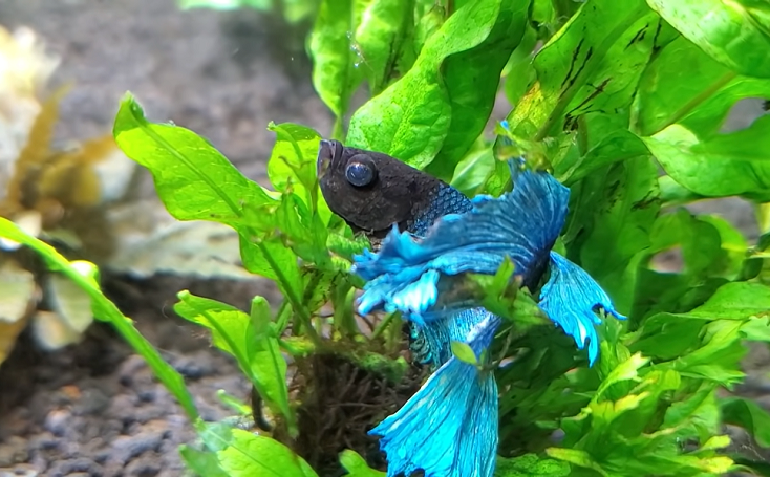
- New fish being added to the aquarium – Extra fish, extra waste
- Overfeeding – If fish are eating too much, they’re going to produce more waste.
- Poor water circulation and filtration – Harmful chemicals, fish waste, and food can become stagnant.
- Not cleaning the tank properly or not testing the tank water
- Poor water sources – Chlorine and fluoride are two toxins in city water that can be harmful to fish.
Now let’s talk nitrates…When ammonia oxidizes, it becomes nitrites which eventually become nitrates (nitrogen). Low concentrations of macronutrients like nitrates help aquarium plants grow, but when the level gets too high, algae can form, and your Betta fish can suffer and even die.
It’s a code red if you see Betta laying at the bottom of the tank for this reason. Be sure to combat the problem by:
- Keeping the betta tank clean
- Testing the water (Regular water changes are important.)
- Adding chemical filters
- Only using purified water for replacement or top-off
- Not overfeeding your fish
Also, research microbes that ward off nitrates.
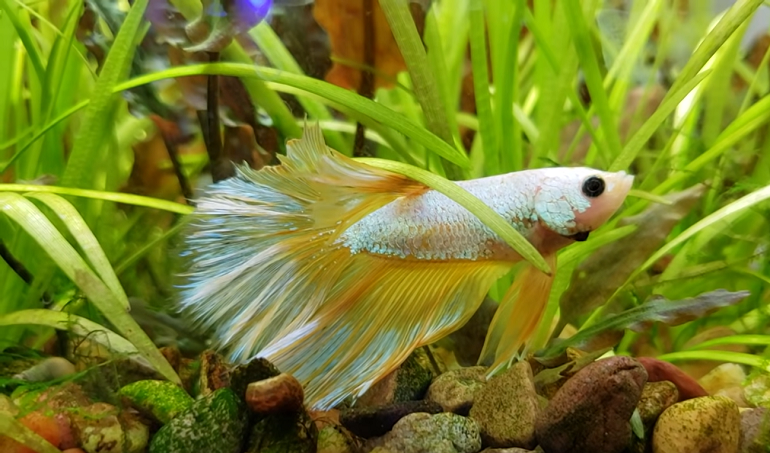
Next, we’ll talk about diseases your betta fish can acquire. There are three categories:
- Bacterial
- Fungal
- Parasitic
Any time your betta fish is stressed due to illness, it might lay at the bottom of the tank.
Fin Rot (Bacterial and/or Fungal)
Could they not have come up with a nicer name? One of the most common ailments of Betta fish is fin rot. If your Betta has a weakened immune system (generally due to their environment/habitat), they’re more susceptible to this condition.
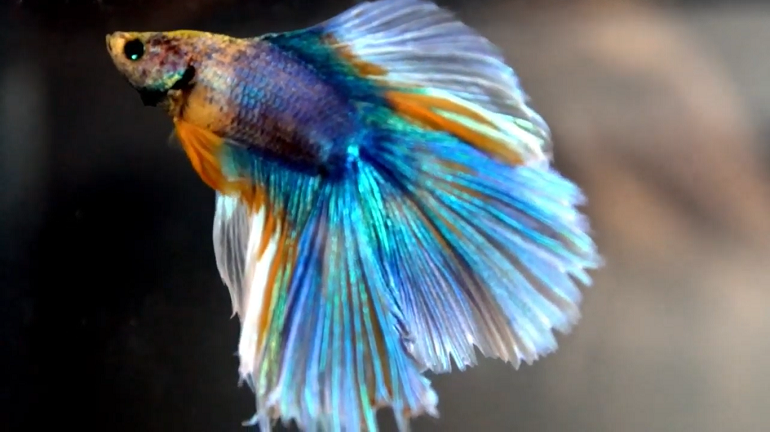
It’s usually not deadly and can be caused by bacteria in the water. Here are some other reasons why your Betta fish may have fin rot:
- Cold water
- High levels of nitrites, nitrates, or ammonia
- Dirty tank
- Overcrowding (fish)
- Overfeeding or underfeeding
- Fungal infection
- Underlying disease
Contrary to popular belief, Betta fish need some space. Here’s what it means: Fin rot is frequently observed in smaller, uncycled ecosystems such as bowls, which do not provide suitable environments for betta fish. The appropriate tank size for bettas is 5 gallons, with 2.5 gallons being the absolute minimum requirement.
Treatment for fin rot depends on which stage it’s in: Mild, moderate, or severe. Check online for directions.
Columnaris (Bacterial)
This infection, often mistaken for fin rot, enters from other tanks either through fish or anything else that’s in the aquarium. Symptoms are:
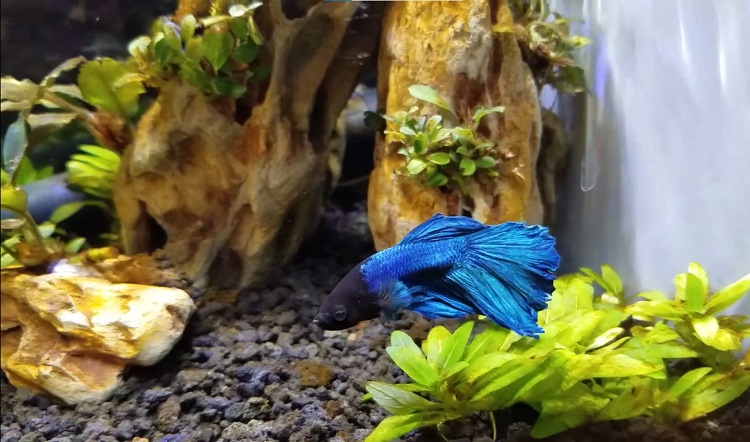
- White or gray patches on the skin
- Frayed or disintegrating fins
- Open sores
- Loss of appetite
Treatments include moving the Betta fish, cleaning the tank, and administering medication.
Hemorrhagic Disease (Bacterial)
This disease is fairly common in Bettas and found in most freshwater tanks. Fish will have red lesions on the body and fins and can accelerate into hemorrhaging from the fins, gills, or eyes.
There’s no cure for this disease. Only prevention… by keeping the tank clean, changing the water regularly, and not overfeeding since food decays and releases bacteria into the water.
Dropsy (Bacterial)
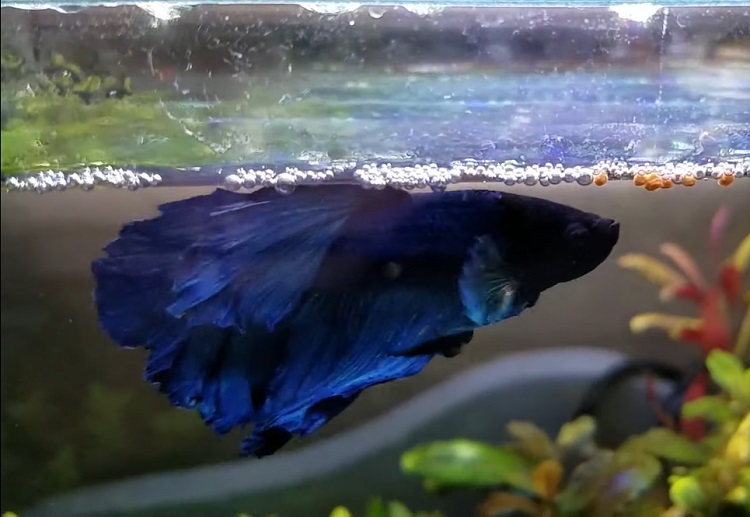
The cause of dropsy isn’t known. It causes fluid buildup in the body, and the symptoms are:
- Scales that protrude from the body (“pinecone”)
- Bloated abdomen
- Loss of appetite
In severe cases, Betta fish can have seizures or die. Try to catch it early to treat, which includes steps like administering antibacterial medication and making sure your fish is on a proper diet.
Eyecloud (Bacterial)
Eyecloud is when the cornea is enflamed and shouldn’t be confused with pop eye (when the eye is bulging).
[It] can be caused by several things, including infection, poor water quality, or trauma to the eye. The symptoms of eyecloud include:
- Cloudy or milky appearance to the eye
- Redness or discharge from the eye
- Swelling of the eye
The treatment includes removing your Betta from the tank, giving him or her a saltwater soak, and administering an antibacterial medication.
Swim Bladder or Bloat (Bacterial)
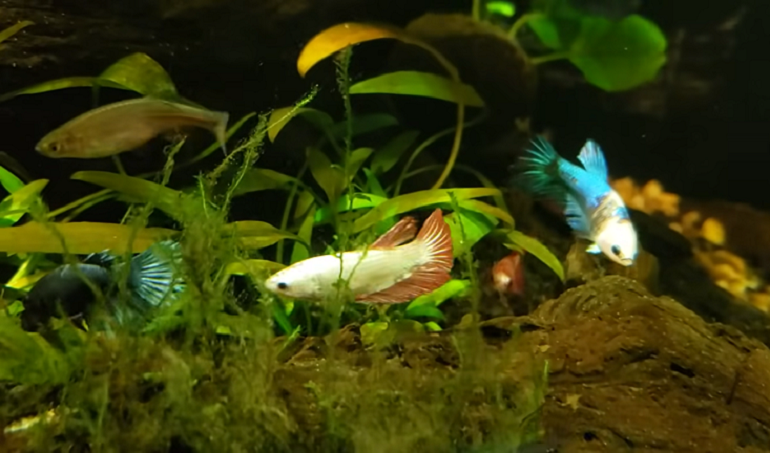
Bettas have this illness when the swim bladder – a sac-like organ that helps with buoyancy – swells. It’s tough to diagnose since it can be caused by an infection, constipation, or from having an adverse reaction to a medication.
The main symptom is when a fish is having a hard time swimming. He might float to the top or lay on the bottom of the tank if he’s infected.
Treatment includes giving your Betta high-fiber foods and administering an antibiotic.
Tuberculosis (Bacterial)
This is a tough one. It is fatal and can be transmitted through open wounds or contaminated food. The bacteria live in salt and fresh water.
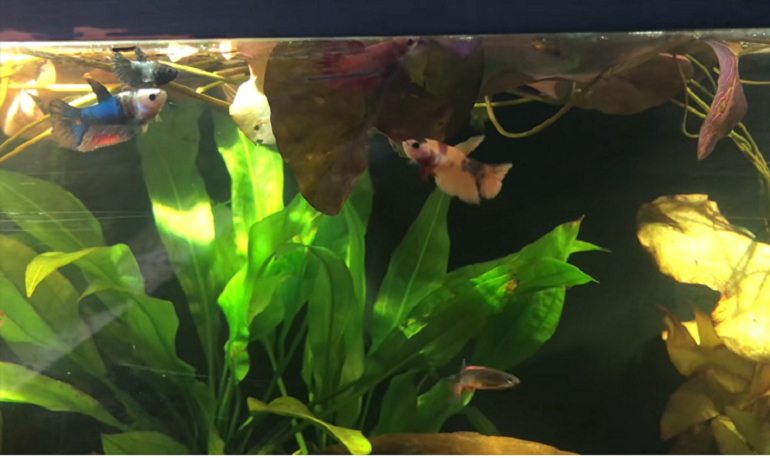
Symptoms may include:
- Loss of appetite
- Weight loss
- Lethargy
If the infection progresses, symptoms become extreme. The Betta may lose scales and have open sores and a fraying tail. It’s no joke!
There is no treatment. Try not to let your dying Betta fish suffer. Giving it a humane death will save him lots of pain. No flushing, please!
Velvet and Ich (Pronounced “Ick”) Parasitic
Velvet disease is a deadly parasitic infection. Many things can carry it into your tank since it’s usually spread unknowingly from another location. Note: Remember this if your fish came from a pet store aquarium.
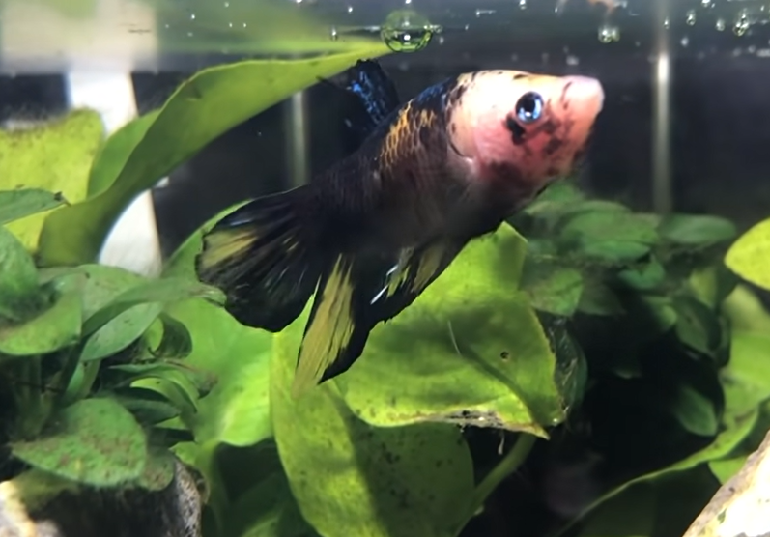
This disease causes fish to become orange-ish or rust-colored, so if your Betta is already orange, it can be tough to recognize. The parasite can also catch a ride into your tank via:
- Fish
- Snails
- Shrimp
- Plants
- Filters
- Decorations
Ich is a protozoan parasite that is extremely common and deadly and lives in aquariums. You can easily see the white spots on your fish that accompany this disease. It’s commonly called the white spot disease.
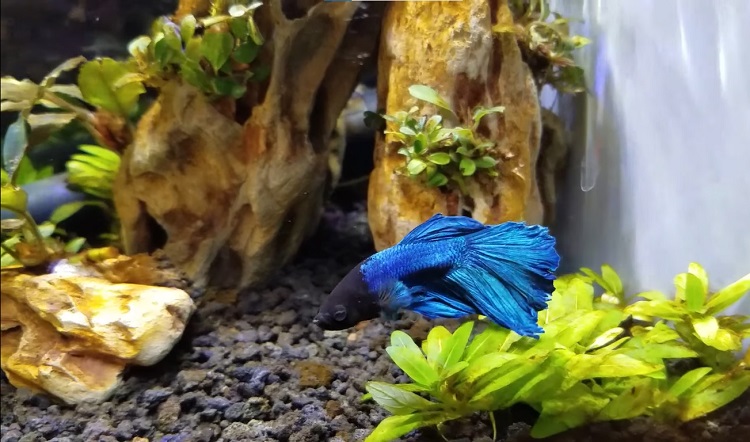
Fortunately, that’s telling you it’s in the first stage of a 4-stage cycle, so there’s time to treat it. It’s also highly transferable from one tank to another via:
- Fish
- Invertebrates
- Plants
- Decorations
- Maintenance equipment -Gravel vacuum or nets
Your best bet is to take steps to prevent either of these diseases from reaching your aquarium by:
- Isolate/Quarantine your Betta if you have more than one fish.
- Slowly turn up the water temperature. (Make warmer.) The parasite doesn’t like it.
- Make sure the betta tank is in the dark. This parasite requires light.
- Check the water to make sure the levels are healthy.
- Use a velvet disease treatment from your pet store or online.
- Change water daily in increments of 25% or 50%.
- Quarantine ANY new fish or anything else that will be entering the fish tank, for at least two weeks.
And remember: Don’t confuse worn fins as a disease or an illness every time. Crowntail bettas can have torn-looking fins naturally.
What Are Some Problems That Must Be Addressed?
Now let’s look at a list of routine problems that might be the cause of your Betta fish laying at the bottom of the tank.
A Small Aquarium
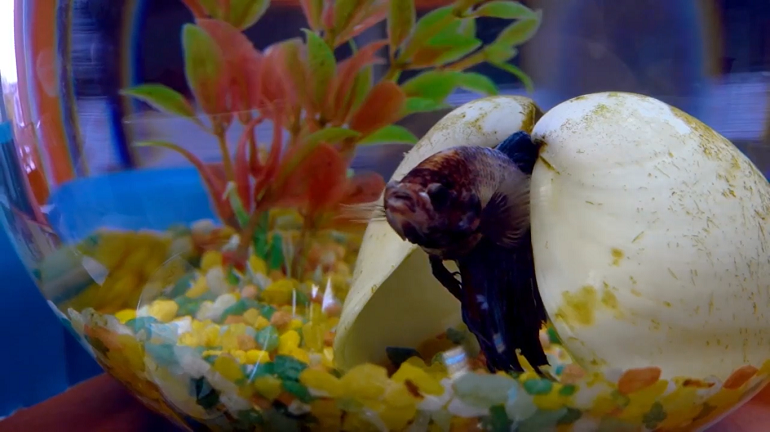
Sure, Bettas can tolerate small spaces, but dogs can tolerate thunderstorms, and that doesn’t mean we leave them out in one. Do the humane thing and give your fish a home that has at least five gallons of water.
Don’t put your Betta fish in a “puddle” to live in. This will ensure the health and happiness of your little one.
Temperature Fluctuation
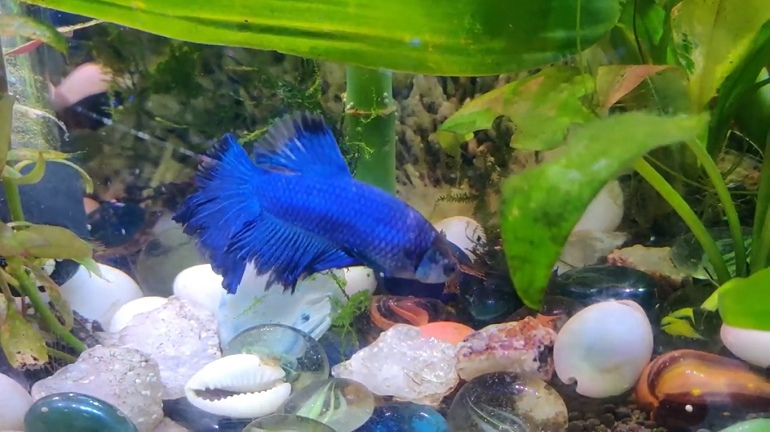
Betta fish are tropical fish. So for them to thrive (and isn’t that what all of us want?), the ideal water temperature for them is 78 to 80 degrees Fahrenheit. If you can’t keep it in that exact range, you might want to get a cat.
They can (just) survive in any temperature between 72 and 86 degrees Fahrenheit. If temps fall below 72 or above 86 or if there are quick temperature changes, a Betta can go into shock, bloat, or die.
Incorrect pH
It’s as important as every other water parameter in your aquarium. And we’re not talking about their shampoo.
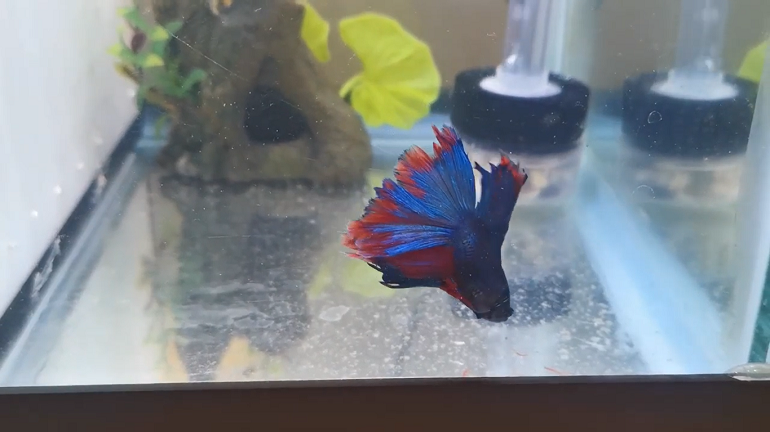
pH is the scientific measure of water acidity or basicity, represented on a scale from 0.0 to 14.0. A pH level of 7.0 is considered neutral for water. pH values below 7.0 indicate acidity, while values above 7.0 indicate alkalinity. Betta fish thrive in water with a neutral pH level of 7.0.
If you’re wondering how to lower the pH in a freshwater aquarium, there are definitive choices you can take to make the aquatic habitat comfortable.
Lack of Filter or Use of Improper Filter
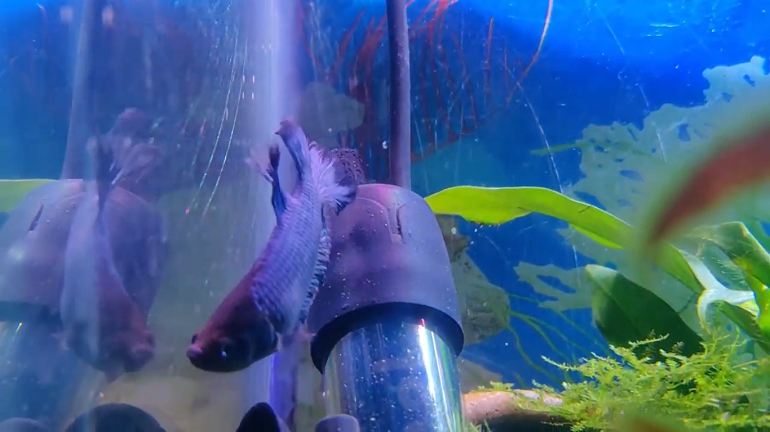
Not using a filter is dangerous for a Betta since it can lead to poor water conditions and eventually fish deterioration. A large filter going full-blast can also be detrimental to them since it can make the current too strong.
Improper Eating Habits
Almost every negative situation we’ve mentioned in this article could be improved on if Bettas are on a proper balanced diet. If they don’t get enough protein, it’s going to affect them in some way and could shorten their lives drastically.
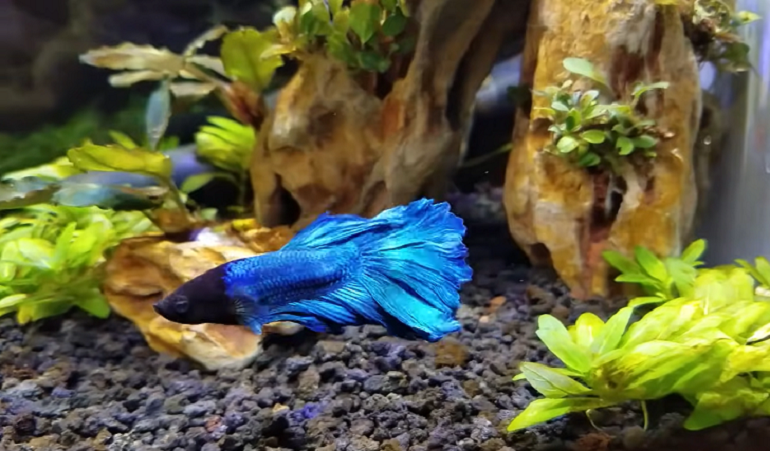
Lack of freshwater aquatic habitat
Avoid using the following in your Betta’s tank:
- Sharp decorations and metal items (could tear fins)
- Painted ornaments (coating flakes)
- Seashells, beach sand, or dried coral (can alter pH)
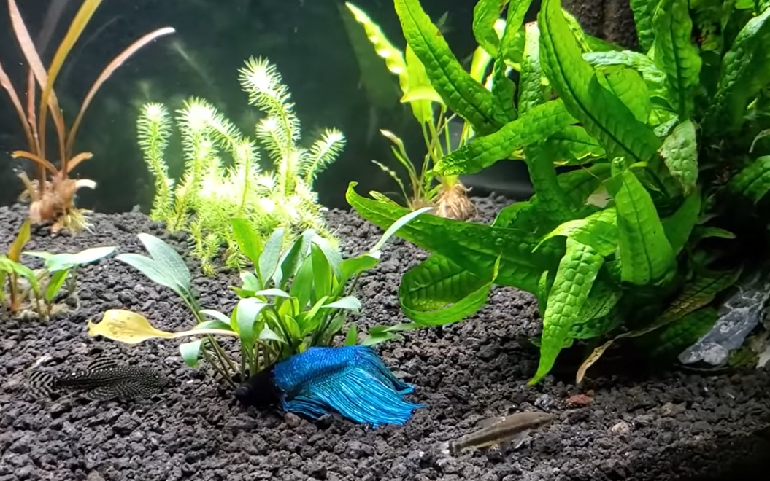
What you can do is have-at-it with plants. Bettas love to hide in plants, plus, they reduce stress and provide safety for them. Don’t forget to continually monitor live plant growth so it won’t impede a betta’s ability to come to the surface for food and air.
Wrong Tank Mates
Have you ever had a bad neighbor? Me, too. But if a Betta has one, it could be the end of its life. Here is a list of tank mates that are bad choices to live with bettas:
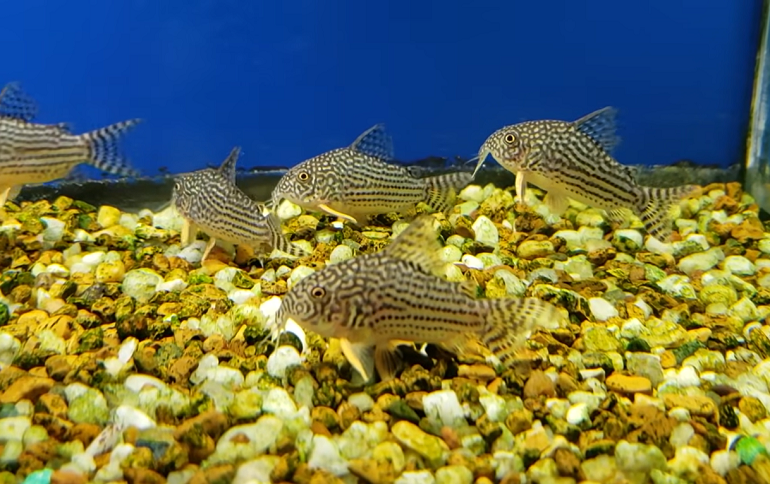
- Large-finned Bettas – They’re sluggish due to their size and are easily targeted to spar with. Bites can turn into sores which can become infected and be introduced to the entire community
- Most schooling fish – They’re too active and need cooler water temperatures.
- African dwarf frogs – Could be nipped at and can be easily beaten when going for food
- Ghost shrimp – Can damage bettas.
- Goldfish – Grow too large and need cold water.
- Cichlids – Aggressive, large, active… you might as well put a bird in the tank.
- Gourami – Although they’re related, the two are rivals. (Kind of like my aunt coming to Thanksgiving dinner.)
Bottom line? Go easy on the tankmates. Besides, the Betta is a solitary, aggressive fish. What’s it to ya?!
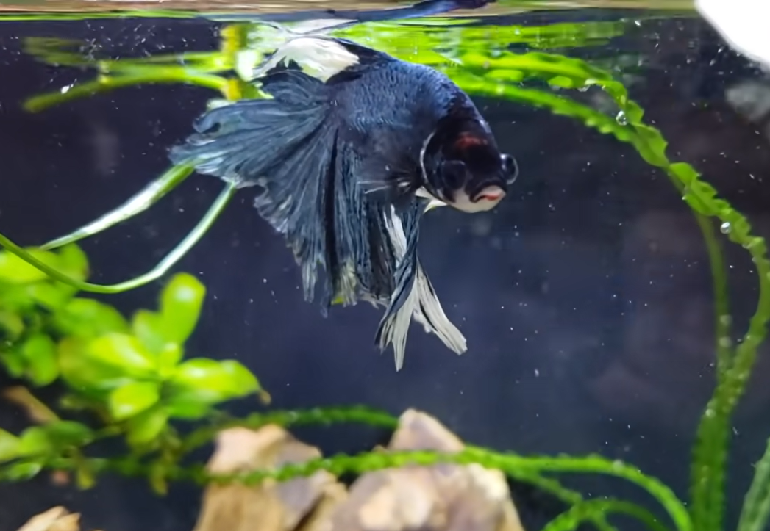
FAQ’s
What Causes a Betta Fish To Lie on Its Side?
This behavior is often seen in bettas that have swim bladder disease.
(Also floating on the surface and laying at the bottom of the tank.)
What Causes Them To Lay at the Bottom of the Tank Upside Down?
Again, swim bladder disease will get them every time. Check out how to treat it.
What if They’re at the Bottom of the Tank Breathing Heavily?
- Lack of oxygen
- Ammonia poisoning
- Disease
- Container’s too small
- Water temperature (Too hot or cold)
- Overcrowded (Too many fish)
There are solutions for each of these online.
What Fish Can Coexist With Betta Fish?
If you must get a playmate for Finny, choose from the following. I didn’t include every fish you could consider since some were iffy, but do your homework and be careful who you bring in. We don’t think it’s worth the risk.
- Kuhli Loaches
- Hara jerdoni catfish
- Is it normal for a betta fish to stay still?
It’s common, but keep an eye on him to make sure he’s not sick.
What Are the Differences Between a Sleeping and Dying Fish?
They’re sort of like people. Check to see if they’re breathing normally (gills moving steadily in and out and mouth opening and closing). A few of the more unusual positions for them to sleep in are:
- Vertically with their heads pointing down
- On top of a leaf that’s lying on top of the aquarium water. Although they can breathe out of water, they still need to stay moist, and lying on a leaf is the answer to that.
- Laying at the bottom of the tank
“Wow!” Facts About Betta Fish
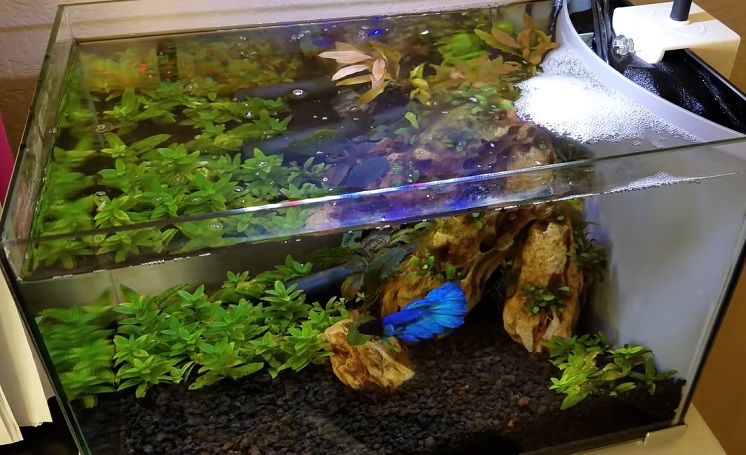
- You wouldn’t think Betta fish have a large family tree, but they do! With more than 70 relatives, they’re rather complex.
- Betta fish are omnivores, meaning they eat both plant matter and meat. Who knew?!
- The International Union for Conservation of Nature (IUCN) includes the Betta on the IUCN Red List of Threatened Species and shows they are vulnerable or that their numbers are decreasing.
- They can breathe atmospheric air! This feat is possible due to an organ they have called the labyrinth.
- Wild bettas are muted in color rather than flamboyantly colorful and have shorter fins. The pet trade has bred them to look so fancy.
And Finally
They say a healthy Betta is a hardy fish, but there’s always the chance any of the illnesses, diseases, or infections mentioned here can overcome your charming friend. So your best defense is a good offense:
- Keep your aquarium pristine.
- Check water levels frequently.
- Quarantine anything you’re going to put into the Betta tanks.
- Educate yourself on betta fish care.
So if you find Nemo at the bottom of the tank looking sluggish, it may be due to any number of reasons why. Take the time to do your research. Know what can and can’t happen and learn what you should and shouldn’t be doing.
Your betta fish depends on you for its food, its safety, and its health. So be the kind of person he can trust. Long live the Betta!












